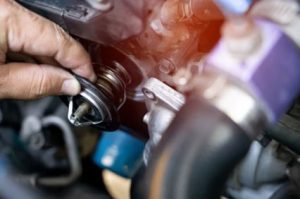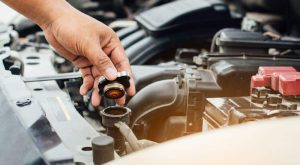Your car’s cooling system is a finely tuned orchestra, where the thermostat and radiator play lead roles. The thermostat, a temperature-sensitive valve, orchestrates coolant flow, ensuring the engine warms up quickly and maintains optimal operating temperature. The radiator, meanwhile, acts as the system’s heat exchanger. Equipped with cooling fins and circulating coolant, it dissipates engine heat into the surrounding air. Together, they ensure performance, efficiency, and engine longevity.

Why They Matter
-
Engine Efficiency: The thermostat ensures rapid engine warm-up and stability at ideal temperatures, boosting fuel economy and emissions control.
-
Preventing Overheating: The radiator continuously expels heat, stopping the engine from reaching critical temperatures.
-
Avoiding Wear & Tear: Proper temperature control reduces thermal stress, prolonging the life of engine components.
The Thermostat: Your Engine’s Gatekeeper
Role & Mechanism
-
Closes when the engine is cold, letting it heat up quickly.
-
Gradually opens (typically between 85–95 °C), allowing coolant flow to the radiator.
-
Fully opens at high temperatures to maximize heat rejection.
Types of Thermostats
| Type | Operation | Common Use |
|---|---|---|
| Wax-pellet (most common) | Wax expands/contracts with temperature | Everyday passenger vehicles |
| Electric actuator | Controlled electronically | Modern vehicles, smooth temp control |
| Dual-stage thermostats | Open in stages for cold-weather use | Heavy-duty or performance engines |
Common Issues
-
Stuck Closed: Overheating and coolant pressure spikes.
-
Stuck Open: Extended engine warm-up time, leading to inefficiency and poor heater performance.
The Radiator: Your Vehicle’s Heat Hub
Core Function
-
Circulates hot coolant through thin tubes and fins.
-
Airflow (from the fan or vehicle movement) cools the coolant before it returns to the engine.
Key Components
-
Tubes & Fins: Maximize surface area for heat exchange.
-
Cooling Fan: Provides airflow when the vehicle is stationary or moving slowly.
-
Pressure Cap: Maintains system pressure to raise boiling point and prevent leaks.
Types of Radiators
-
Standard copper/brass: Older models, heavy but reliable.
-
Aluminum crimped and plastic-tank: Common modern design — lightweight and efficient.
-
High-capacity (performance/racing): Larger cores and stronger materials for extreme conditions.
How They Work Together
The thermostat blocks or allows coolant flow to maintain the engine between ~85–95 °C. When open, coolant travels to the radiator, where airflow removes engine heat. The cooled liquid then re-enters the water pump and engine block for continuous temperature control.
System Cycle
Thermostat closed → coolant circulates within the engine → engine warms up → thermostat opens → coolant flows to the radiator → cooled and cycled back.
Typical Cooling System Temperatures
| Engine State | Coolant Temperature (°C) |
|---|---|
| Cold start | 20–40 |
| Warm-up | 50–85 |
| Normal operation | 85–95 |
| High load/overheating | 100+ |
Maintenance & Troubleshooting
Periodic Checks
-
Inspect hoses for cracks/leaks.
-
Monitor coolant levels and quality.
-
Ensure radiator fins are free of debris.
-
Test thermostat function by observing temperature rise and engine behavior.
Troubleshooting Guide
| Symptom | Likely Cause | Recommended Fix |
|---|---|---|
| Cold engine for long time | Stuck-open thermostat | Replace thermostat |
| Rapid overheating | Stuck-closed thermostat or clogged radiator | Test thermostat, flush radiator |
| Coolant loss or leaks | Damaged radiator core/hose | Replace component, pressure test |
| Overheated in traffic only | Faulty cooling fan | Inspect fan/fuse/relay |
Tips to Maximize Lifespan

-
Use the correct coolant as per the manufacturer’s specifications.
-
Regularly service the system (coolant change every 2–3 years).
-
Replace thermostat and radiator cap together to ensure reliability.
-
Watch for oscillating gauge readings — they often indicate thermostat or contact issues.
-
During hot months or towing, consider installing a high-performance radiator or electric fan upgrade.
Why It Matters
-
Efficient Operation: Engine runs optimally, saving fuel and reducing wear.
-
Avoiding Breakdowns: Prevents overheating and costly repairs.
-
Environmental Compliance: Stable temps help engine controls meet emissions targets.
When it’s time to replace worn components, consider performance-ready options.
Buy Radiator & Components online — quality, fast delivery, perfect fit for your cooling system.
Conclusion
The thermostat and radiator form the backbone of your car’s cooling system. The thermostat controls when and how much coolant flows based on temperature, while the radiator efficiently dissipates engine heat. Keeping both components well-maintained ensures optimal engine performance, longevity, and reliability.
Regular inspection, timely replacement, and choosing quality parts ensure your engine stays cool under pressure — literally — and keeps you confidently on the road.